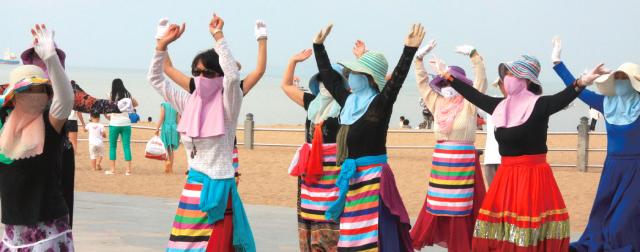In the city of Sanya’s Haiyue Square, Zhu Cheng’en looked like an answer to the classic standardized-test question: What doesn’t belong? Sporting a tailcoat, black bow tie and black-brimmed fedora covering all but a few stray tufts of gray hair, Zhu stood out from the casually dressed crowd who came to while away another warm winter day in the southernmost city of tropical Hainan Province. A 90-year-old man born in the northern province of Shandong, Zhu told NewsChina that this was the first winter he had spent outside his hometown.
Haiyue Square was Zhu’s daily stomping ground during his Sanya stay. There, groups of senior “snowbirds” like Zhu gathered to dance, play mahjong or chat. Every morning, they emerge from their temporary homes – a nearby row of crowded, cramped apartment buildings – and socialize in the square until the last dance song hits its final notes.
Thanks to southern China’s reliably warm weather and clean air, more and more retirees from the frigid north are traveling south for the winter, just like migratory birds. This temporary population injection has greatly advanced destination cities’ tourism industries, cultural activities and real estate markets, while at the same time laying a heavy burden on their infrastructure and social services, a weight which local governments may be too ill-equipped to bear.
Torrential Tourism To Zhu, whose wife died several years ago and whose children live elsewhere, Sanya has given him a new lease on life. He spent his winter dancing in Haiyue Square, where he made many friends, an easy task as a former dance teacher with exceptional moves. If he waltzed too late into the night and missed the last bus, he would hop on the back of a motorcycle taxi for a small fee. According to the local media, the annual deluge of winter visitors jams the roads, leading to rampant use of unlicensed motorcycle cabs, despite a police crackdown.
Yet Zhu was enamored by Sanya life. “I can dance freely here,” he said. “It makes me extremely happy.” He even moved to a cheaper hotel so that he could extend his stay.
For 75-year-old Huang Yimin, the Sanya newness that excited Zhu is simply her status quo, since she has lived in Sanya off-and-on for 14 years. Persuaded by advertisements touting the city’s temperate winters, Huang and her husband migrated south in December 2001. The next winter, in Sanya once again, Huang said she experienced a miracle – the sight in her right eye, which had been destroyed by a brain hemorrhage in 1986, gradually returned. Since then, Huang believed that the Sanya climate could add years to her life and decided to settle there. In 2003, she and her husband sold their house in Harbin, capital of the northeastern province of Heilongjiang, and bought a new one in Sanya.
Now, Sanya accommodates about 380,000 of these “migratory seniors.” This is more than six times the local over-60 population.
According to a 2014 finding by the Heilongjiang government, 10 percent of Heilongjiang residents over 60 years old travel south every winter, with Hainan listed as their first-choice destination.
But they will fly anywhere that is south enough for sun. The majority of China’s most livable cities are located south of the 25th parallel north, where winter temperatures hover around 15-25 degrees Celsius,
according to a 2014 report on China’s most livable cities co-published by Tsinghua University Urban Planning and Design Institute, The Real Estate Academy in China and the webportal Sohu. Apart from Hainan, parts of Yunnan Province, Guangdong Province and Guangxi Zhuang Autonomous Region also fall under this umbrella.
Tengchong, Yunnan Province, is another prime example of a southern city swarmed by northerners. Characterized by widespread hot springs and lush forests, Tengchong received over seven million tourists in 2015, three times more than in 2008. According to Zhao Limin, the deputy director of the local tourism bureau of Tengchong, 60 percent of those tourists were senior citizens, whose individual numbers have been rising 20 percent each year. Similarly, Bama, a small Guangxi county that is well known for its residents’ longevity, was home to 150,000 newcomers in 2010, two-thirds of whom were seniors.
Huang Huang, a China Tourism Academy researcher who is analyzing the trend of migratory seniors, told NewsChina that the industries of elderly care and senior citizen tourism in China in 2015 amounted to 450 billion yuan (US$69.2bn) and 320 billion yuan (US$49.2bn), respectively. Based on these numbers, he estimated that the migratory seniors market value may exceed 200 billion yuan (US$30.8bn).
Group Living As an early adherent of the snowbird lifestyle, Li Shufan, Huang Yimin’s neighbor, has borne witness to how migratory seniors have influenced Sanya. “It used to be a wasteland, just a pile of dirt,” she pointed at her community. Now, high-rise apartment buildings blanket the area.
The real estate sector has benefited significantly from the influx of tourists seeking sunnier climes. Just five days after the government defined Hainan as an “international tourism island” in 2010, the province’s property sales soared to 17.1 billion yuan (US$2.6bn), an amount equivalent to Hainan’s total real estate sales in 2008, according to a State Council document on Sanya tourism.
The rocketing housing prices, however, have forced many seniors to rent cheap apartments instead of buying property, as Huang Yimin did. Most of the migratory seniors, at least from Harbin, are working-class retirees living off a monthly pension of 1,000-2,000 yuan (US$154-308), according to Wang Ying, a researcher from Harbin who was sent to Sanya to study the snowbird phenomenon.
Because they are too old to apply for bank loans, renting cheap housing is their only option.
Li Baosheng, a retired swimming coach who came to Sanya in 2013, for example, could not afford an office space for her swimming club, an addition that would bring it to a level of professionalism she had dreamed about for years. The average housing price in Sanya exceeded 18,000 yuan (US$2,769) per square meter in 2015, a price point far beyond her reach, she told NewsChina.
She lives in a rundown boarding house hidden behind a row of high-end hotels. Her area is overloaded with privately constructed buildings that have been crammed together in a poor attempt to accommodate the rocketing demand for housing. Many of them do not meet regulations. In order to earn more money from renters, local homeowners built high-rise apartments that were packed so densely that the media dubbed them “handin- hand houses.” A similar phenomenon has hit Bama in Guangxi. Although both local governments have tried to crack down on these illegal and at times dangerous buildings, high demand and sizable profits for the perpetrators have nullified government efforts to tighten supervision.
In addition to these privately constructed apartment buildings, senior citizen group homes are another popular choice for older snowbirds. Tenants live in uniform, simple rooms and receive three meals a day. The retirees go out together to dance or exercise every morning, coming back at meal times, just as they used to come back to communes run by their State-owned enterprise work units in decades past.
Despite generally poor living conditions, most migratory seniors seem to have acclimated to their new life in Sanya and have formed social circles of their own. In many such communities, residents, including street vendors, generally speak with accents that hail from up north, and northern-style restaurants are more plentiful than ones serving local fare. Many netizens even joke that Sanya is just another city in Heilongjiang.
Huang Cheng, a Sanya University researcher studying senior care, found that nearly 50 percent of seniors in Sanya choose collective care, while that number is less than 20 percent in other cities around the country, such as Hangzhou in Zhejiang Province or Dalian in Liaoning Province. As migratory seniors are unfamiliar with their new homes and are far away from their traditional support networks, they are more likely to lean toward communal living for mutual care and companionship, he suggested.
Local Clashes Although these southbound seniors have contributed greatly to the local economy, they have angered many locals who accuse outsiders of stealing their resources and clogging up traffic. In Sanya, for example, conflict between the two groups peaked in late 2015 when Bi Guochang, a 65-year-old man from Harbin, posted an Internet rant that caused a stir online. He wrote that his clothes and bicycle had been confiscated by a local chengguan (employee of the local urban management bureau) after he took a dip in a no-swimming zone, forcing him to hobble back home, half-naked. Bi criticized the chengguan for discriminating against outsiders, while locals hit back online, saying that the migratory seniors have disturbed the city’s social order.
Such mutual antipathy is nothing new. Li Shufan, the early snowbird, told our reporter that she had seen banners that read “Get out of Sanya, northerners” swinging on street corners. They made her feel helpless, a feeling exacerbated by the fact that doors that are typically open to seniors with problems are closed to those away from home.
“The migratory seniors are a big headache for us; they have caused a lot of societal problems,” Zheng Conghui, deputy director of the Sanya tourism bureau, told NewsChina.
“It is like a host having only one table, but
trying to receive two tables’ worth of guests.
The host cannot take care of every one.” The situation in Bama was even more pronounced. As a poverty-stricken county, Bama’s local infrastructure could not handle the waves of visitors, so the formerly quiet, beautiful county transformed into an overcommercialized tourism site with a destroyed ecosystem. While locals blamed their rivers’ heavily polluted state on newcomers who use them to bathe or wash their feet, the newcomers grumbled that they have not received the quality services that tourism advertisements had promised.
A report by Beijing Evening News found senior snowbirds’ top three concerns to be loneliness, high cost of living and inconvenient services. Huang Yimin, for example, had to come back to Harbin in 2008 after her husband fell seriously ill, as Chinese medical insurance is only obtainable in one’s domicile.
“Many tourism-driven cities have targeted the migratory seniors market, but I don’t think they are prepared [for them],” said China Tourist Academy researcher Huang Huang. Many analysts believe that most of these destination cities are still in a honeymoon phase with this emerging market – they covet the benefits snowbirds bring along, like rapid development in the tourism and real estate industries, but make few improvements to support services. Lacking confidence that migratory seniors will keep returning in the long run, they feel reluctant to invest more in a potentially temporary group of residents.
To Sanya University researcher Huang Cheng, governments need to start facing reality and take action to deal with their cities’ altered demographics. During his research, he found that many migratory seniors are full of life and well-educated. They would play a bigger role in developing these cities if given proper government guidance.
Changes Hainan has begun to take some measures in this area in the past three years. The local government in Sanya has expanded its cooperation with Heilongjiang Province to provide cross-province medical care, allowing several hospitals and pharmacies to accept medical insurance from Heilongjiang natives. In 2012, The Old-age Commission of Harbin set up an office in Sanya to help snowbirds lead a better life while down south. The commission later established an association with over 3,300 members, becoming Sanya’s only government-approved NGO serving migratory seniors.
For its part, Bama has invested more funds into waste disposal and pollution control. In an interview with Legal Weekly, Wei Mingfu, the director of the county’s housing and urban construction bureau, admitted that the local government should be held partly responsible for the rampant unauthorized construction, since they failed to create a sufficient plan for the surge of visitors. Now, the government is retooling the city plan and working out a program to better manage and serve migratory seniors, especially in regards to public security and healthcare.
To lighten the burden on Bama’s scanty resources, the local government also launched a campaign in September 2013 to divert migratory seniors to neighboring towns and counties by building up those areas’ ecotourism image. This seems to be a viable strategy – in fact, some Sanya snowbirds have naturally flown to its neighboring areas after being subjected to Sanya’s traffic jams and soaring prices. Some Sanya business owners who rely on snowbirds for income are starting to worry that their customers are nesting elsewhere.
Group home owner Lang Yuling is one of them. Her business hasn’t thrived in the past two years as it did before. She rents rooms out to temporary workers in the summer, but in the winter she depends on migratory seniors to stay afloat. “If I can’t rent my rooms out in the winter, it means they will spend half of the year empty,” she told NewsChina.
Researcher Huang Huang predicts that not only will Sanya snowbirds continue to fly to nearby cities, they will fly overseas as well. “Given the huge commercial potential for senior citizen tourism, I think the market trends will keep changing, and may extend to countries like Thailand or Malaysia,” Huang said.

 Old Version
Old Version

